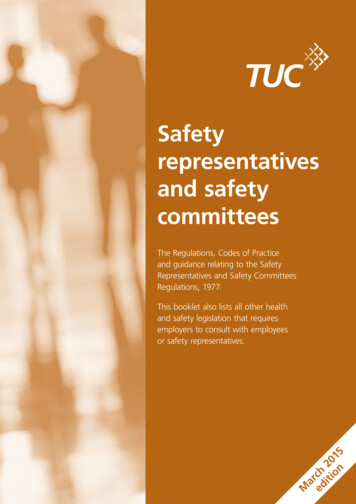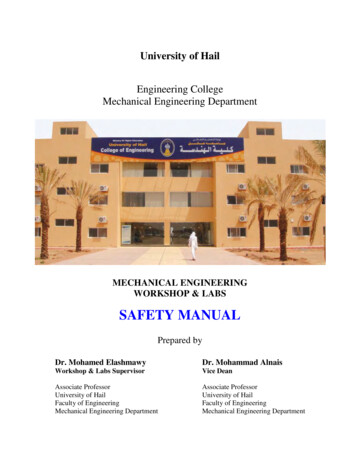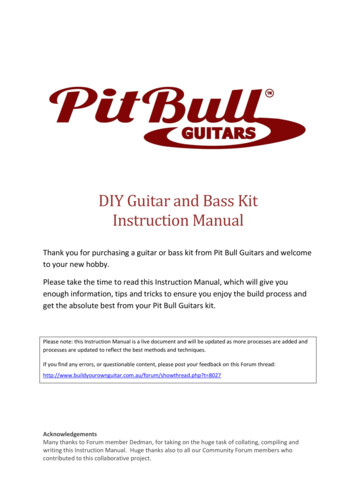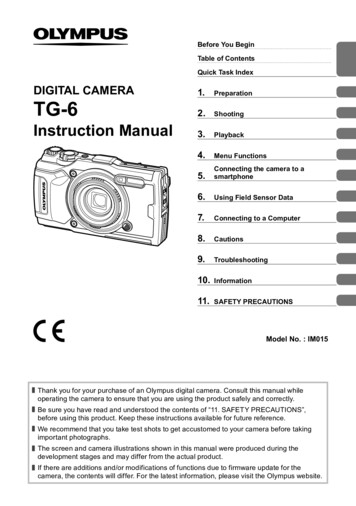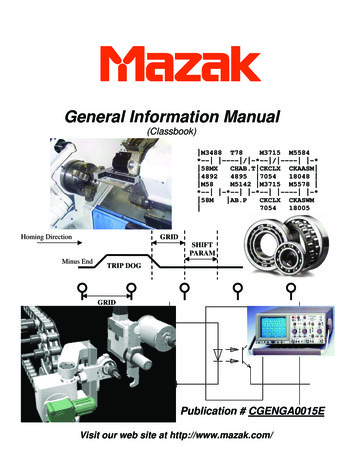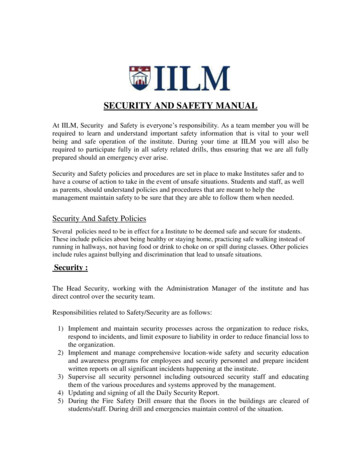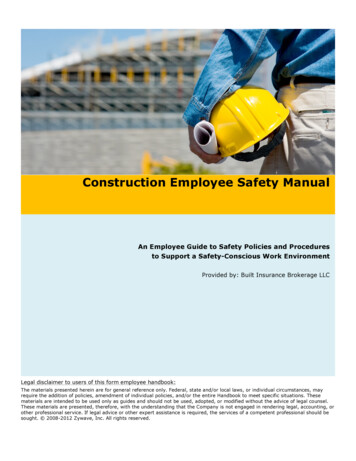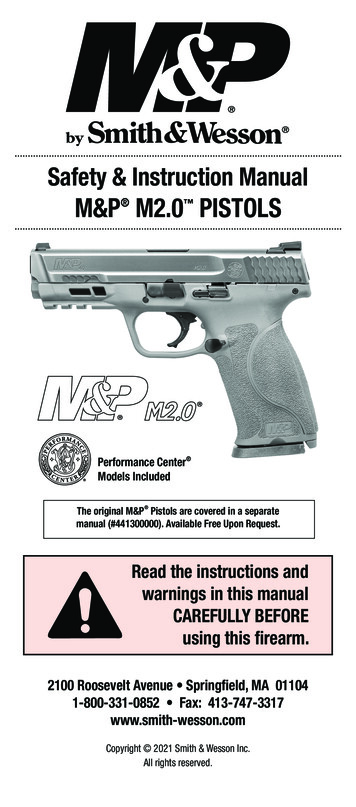
Transcription
Safety & Instruction ManualM&P M2.0 PISTOLS Performance Center Models IncludedThe original M&P Pistols are covered in a separatemanual (#441300000). Available Free Upon Request.Read the instructions andwarnings in this manualCAREFULLY BEFOREusing this firearm.2100 Roosevelt Avenue Springfield, MA 011041-800-331-0852 Fax: 413-747-3317www.smith-wesson.comCopyright 2021 Smith & Wesson Inc.All rights reserved.
WARNING:READ THESE INSTRUCTIONSAND WARNINGS CAREFULLY. BE SUREYOU UNDERSTAND THESE INSTRUCTIONSAND WARNINGS BEFORE USINGTHIS FIREARM. FAILURE TO READ THESEINSTRUCTIONS AND TO FOLLOW THESEWARNINGS MAY RESULT IN SERIOUS INJURYOR DEATH TO YOU AND OTHERS ANDDAMAGE TO PROPERTY.This SAFETY & INSTRUCTION MANUALshould always accompanythis firearm and be transferredwith it upon change of ownershipor when presented to another person.A copy of theSAFETY & INSTRUCTION MANUALis available FREEvia download atwww.smith-wesson.comor upon request from:SMITH & WESSON CUSTOMER SUPPORT CENTER2100 ROOSEVELT AVENUESPRINGFIELD, MA 01104TEL.: 1-800-331-0852, ext. 4125E-mail: qa@smith-wesson.com2
TABLE OF CONTENTSYOUR SAFETY RESPONSIBILITIES.3-6SAFE STORAGE AND TRANSPORTATION.7-8AMMUNITION.9-11MODEL AND FEATURES IDENTIFICATION. 12INSPECTING YOUR PISTOL.13-14MANUAL THUMB SAFETY - (If pistol is so-equipped). 15LOADED CHAMBER INDICATOR. 16PREPARATION FOR FIRING.17-18LOADING.18-20FIRING.20-21HANGFIRES AND MISFIRES.22-23CLEARING A MISFEED/JAM. 24UNLOADING. 25FIELD STRIPPING / DISASSEMBLY.26-28LUBRICATION. 29ASSEMBLY.29-31INTERCHANGEABLE PALMSWELL GRIP INSERTS. 32REVERSIBLE MAGAZINE RELEASE.33-34MAGAZINE.34-35SIGHT ADJUSTMENT. 35CLEANING AND MAINTENANCE.36-38LIMITED WARRANTY.38-39CONTACT AND SHIPPING INFORMATION.40-41CORE OPTICAL SIGHT ADAPTER - (If pistol is so-equipped).42-45OVERTRAVEL ADJUSTMENT SCREW - (If pistol is so-equipped).46-49PORTED BARREL WARNINGS - (If pistol is so-equipped). 49BATTERY WARNINGS AND PATENT INFORMATION. 50CUSTOM SERVICE AND INTERNATIONAL WARRANTY CENTERS. 52YOUR SAFETY RESPONSIBILITIESSAFETY IS YOUR NUMBER ONE RESPONSIBILITY! At home, in the field, at the range, or anywhere, the first concern ofevery firearm owner should be safety. Apply the following safety rulesin every situation, with any kind of firearm. If you feel uncertain aboutany operational aspects of your firearm, please contact Smith & Wesson at 1-800-331-0852, ext. 4125 before proceeding with its operation. If you are unfamiliar with firearms you should seek formal trainingbefore using your pistol.WARNING: YOU MUST FOLLOW ALL OF THESE SAFETY RULESTO ENSURE THE SAFE USE OF YOUR FIREARM. THE FAILURETO FOLLOW THE INSTRUCTIONS AND WARNINGS IN THISMANUAL COULD CAUSE SERIOUS PERSONAL INJURY OR DEATH TOYOU OR OTHERS AND DAMAGE TO PROPERTY. As a firearm owner, you accept a demanding responsibility. Howseriously you take this responsibility can be the difference between lifeand death. There is no excuse for careless or abusive handling of yourfirearm. At all times handle your firearm with intense respect for itspower and potential danger.3
YOUR SAFETY RESPONSIBILITIES CONTINUED ALWAYS KEEP YOUR FIREARM POINTED IN A SAFE DIRECTION. Neverpoint a firearm at anyone or anything you do not intend to shoot whetheror not it is loaded. This is particularly important when loading, unloading,or field stripping the gun. ALWAYS control the direction of the firearm. ALWAYS TREAT EVERY FIREARM AS IF IT IS LOADED AND WILLFIRE. Do not take anyone’s word that the firearm is unloaded – alwayscheck for yourself. Never pass your firearm to another person until thecylinder or action is open and you visually check that it is unloaded. Keepyour firearm unloaded and safely stored when not in use. NEVER PLACE YOUR FINGER INSIDE THE TRIGGER GUARD OR ONTHE TRIGGER UNLESS YOU INTEND TO FIRE. Ensure that other objectsdo not touch the trigger. ALWAYS BE SURE OF YOUR TARGET AND WHAT IS BEYOND IT.Always be sure of where the bullet will strike and shoot only where thereis a safe backstop free of obstructions, water or other surfaces whichcan cause ricochets. Be sure your bullet will stop behind your target.Bullets can glance off many surfaces like rocks or the surface of waterand travel in unpredictable directions with considerable velocity. Do notfire randomly into the sky. NEVER CROSS OBSTACLES SUCH AS FENCES OR STREAMS WITHA LOADED FIREARM. Always make certain your firearm is unloadedbefore crossing a fence, climbing a tree, jumping a ditch or negotiatingother obstacles. SAFE GUN HANDLING IS YOUR PERSONAL RESPONSIBILITY ATALL TIMES. Firearms are dangerous and can cause serious injury ordeath if they are misused or used inappropriately. Safety must be theprime consideration of any one who owns or handles firearms. Accidentsare the result of violating the rules of safe gun handling and commonsense. Firearm safety training is available. Contact your firearms dealer,law enforcement agency, local sportsman’s club, etc. for availability. YOU ARE RESPONSIBLE FOR THE FIREARM AT ALL TIMES. In owninga firearm, you must undertake full-time responsibility for your firearm’ssafety and security. You must protect yourself and all others againstinjury or death from misuse of the firearm 24 hours a day. FIREARM SECURITY IS YOUR RESPONSIBILITY. You must securefirearms safely from children and/or unauthorized users. Your firearmshould always be kept unloaded and locked when not in use. A lock hasbeen provided for this purpose. Never assume that the use of this lock issufficient to safely secure your firearm. You must always evaluate yourpersonal situation and employ the security systems that meet your needsand prevent children and unauthorized users from gaining access to yourfirearm.4
YOUR SAFETY RESPONSIBILITIES CONTINUED APPROPRIATE USE FOR YOUR FIREARM MEANS USING YOUR FIREARM FOR LEGAL PURPOSES. For example - target shooting, huntingand lawful resistance of deadly criminal force. It is your responsibility toensure that you are in compliance with all applicable laws and ordinances regarding the use of your firearm. NEVER RELY ON MECHANICAL FEATURES ALONE. Only your safegun-handling habits will ensure the safe use of your firearm. This is yourresponsibility. ALWAYS SAFELY STORE AND SECURE YOUR FIREARM. Safe andsecure storage of your firearm is one of your most important responsibilities. It is a full-time responsibility. You must always secure yourfirearm and ammunition separately so that they are not accessible tochildren and/or other unauthorized persons. NEVER KEEP AMMUNITION IN THE SAME LOCATION AS THE FIREARM. Store each in a separate and secure place. ALWAYS WEAR EYE PROTECTION THAT IS SPECIFIED FOR USE WITHFIREARMS every time you handle your firearm for cleaning and maintenance. ALWAYS WEAR EYE AND HEARING PROTECTION THAT ARE SPECIFIED FOR USE WITH FIREARMS every time you discharge your firearm.Make sure others in the vicinity of where you will be shooting do so aswell. NEVER USE ALCOHOL OR DRUGS BEFORE OR WHILE SHOOTING.Do not use your firearm if you are on any medication which impairs,even slightly, your mental or physical ability. ALWAYS HAVE ADEQUATE VENTILATION. Discharging firearms inpoorly ventilated areas, cleaning firearms, or handling ammunition mayresult in exposure to lead and other substances known to cause birthdefects, reproductive harm, and other serious physical injury. Reviewthe warnings and labels for all ammunition and cleaning productscarefully. Wash hands thoroughly after exposure. BEFORE HANDLING ANY FIREARM, UNDERSTAND ITS OPERATION.Not all firearms are the same. Familiarize yourself with the mechanicalfeatures of any firearm you intend to use. If you feel uncertain about anyoperational aspects of your firearm, please contact Smith & Wesson at1-800-331-0852, ext. 4125 before proceeding with its operation. NEVER ALLOW A FIREARM TO BE USED BY INDIVIDUALS WHODO NOT UNDERSTAND ITS SAFE OPERATION OR HAVE NOT READTHESE FIREARM SAFETY RULES.5
YOUR SAFETY RESPONSIBILITIES CONTINUED ALWAYS USE THE CORRECT AMMUNITION FOR YOUR PARTICULAR FIREARM as indicated by the marking on the firearm. Never usenon-standard, damaged, corroded or reloaded, (handloaded) ammunition which has not been subjected to internal ballistic pressure testing. BEWARE OF BARREL OBSTRUCTIONS. Be sure the barrel is clear ofobstructions before shooting. Mud, water, snow or other objects mayinadvertently lodge in the barrel bore. A small obstruction can cause adangerous increase in pressure and may damage your gun and causeinjury to yourself and others. BE SURE ALL ACCESSORIES, SUCH AS HOLSTERS. GRIPS, SLINGS,SCOPES AND OTHER ACCESSORIES ARE COMPATIBLE with the firearm and that the accessories do not interfere with safe operation. It isyour responsibility to understand and follow all of the instructions in thismanual, as well as those which may be supplied with your ammunitionand any accessory. NEVER DISASSEMBLE YOUR FIREARM beyond the field stripping procedure outlined in this manual. Improper disassembly or reassembly ofyour firearm may be dangerous and can lead to serious injury or death. NEVER MANIPULATE, ADJUST OR CHANGE ANY OF THE INTERNAL COMPONENTS OF YOUR FIREARM UNLESS SPECIFICALLYINSTRUCTED TO DO SO IN THIS MANUAL. Improper manipulation ofany other internal component may affect the safety and reliability of yourfirearm and may cause serious injury or death. NEVER ALLOW ANY ALTERATION OR REPLACEMENT OF PARTS INYOUR SMITH & WESSON FIREARM UNLESS PERFORMED BY AQUALIFIED GUNSMITH using genuine Smith & Wesson parts. If you dootherwise, improper functioning of your firearm may occur and seriousinjury or death and damage to property may result.WARNING: SAFE USE OF A FIREARM IS YOUR PERSONAL RESPONSIBILITY AND THE FAILURE TO FOLLOW ALL OF THESEBASIC SAFETY RULES MAY RESULT IN SEVERE PERSONALINJURY OR DEATH TO YOU OR OTHERS AND DAMAGE TO PROPERTY.YOU ARE THE MOST IMPORTANT SAFETY DEVICE WHEN IT COMES TOTHE USE OF YOUR FIREARM AND SMITH & WESSON WILL NOT BE RESPONSIBLE FOR ANY PERSONAL INJURY, DEATH OR PROPERTY DAMAGE THAT RESULTS FROM: (1) THE CRIMINAL OR NEGLIGENT USE OFTHIS FIREARM; (2) A DISREGARD OF THESE SAFETY INSTRUCTIONSAND WARNINGS; (3) IMPROPER OR CARELESS HANDLING OF THISFIREARM; (4) THE USE OF NON-STANDARD, DEFECTIVE OR IMPROPERAMMUNITION OR; (5) IMPROPER OR NEGLIGENT MODIFICATIONS ORREPAIRS TO THE FIREARM.6
SAFE STORAGE AND TRANSPORTATIONWARNING: ALWAYS POINT THE MUZZLE IN A SAFE DIRECTION.WARNING: FIREARMS ARE DANGEROUS WHEN USED ANDSTORED IMPROPERLY. THEY POSE A RISK OF SERIOUS ORFATAL INJURIES. FIREARMS CAN BE ESPECIALLY DANGEROUS TO CHILDREN WHEN THEY ARE STORED IN AN IRRESPONSIBLEAND UNSAFE MANNER. FOR YOUR SAFETY AND THE SAFETY OFOTHERS, IT IS IMPERATIVE THAT YOU KEEP YOUR FIREARM LOCKEDAND UNLOADED IN A SECURE PLACE. THE AMMUNITION SHOULD BESTORED IN A SEPARATE, SECURE LOCATION WHEN IT IS NOT IN USE.SAFE AND SECURE STORAGE OF YOUR FIREARM IS ONE OF THE MOSTIMPORTANT RULES OF FIREARM SAFETY. YOUR FAILURE TO FOLLOWTHESE RULES MAY RESULT IN SERIOUS INJURY OR DEATH TO YOU OROTHERS. ALWAYS SECURE YOUR FIREARM IN A MANNER THAT WILLPREVENT UNAUTHORIZED ACCESS. Whenever your firearm is not inuse, keep it unloaded and locked. Your safety and the safety of othersrequires that you always secure and store your firearm in a manner thatwill prevent unauthorized access. Never leave a firearm unattendedunless it is locked, unloaded and secured. ALWAYS USE THE LOCK PROVIDED BY SMITH & WESSON TOSECURE YOUR FIREARM. Please read and follow the instructionspackaged separately for the use of this lock. A lock, when properlyused, can be an effective tool in preventing unauthorized access to yourfirearm. There are other alternative locks and safe storage containersavailable in the marketplace which may also be appropriate for yourparticular needs. Consult your local gun shop, hardware store, or localpolice department for guidance on the variety of other safe storagedevices or practices which may be appropriate for your particular needs.By purchasing this firearm you have accepted the responsibility ofsafely securing the firearm at all times and preventing its unauthorizeduse. Never assume that the use of this lock alone is sufficient to safelysecure your firearm. It is your personal responsibility to select and usewhatever measures or practices that will enable you to be absolutelycertain that your firearm is secure at all times.WARNING: NEVER LOCK A LOADED FIREARM AND NEVERLOAD A LOCKED FIREARM!! ALWAYS STORE YOUR FIREARM AND AMMUNITION SEPARATELYso that they are not accessible to children or other unauthorized persons. Safe and secure storage of your firearm and ammunition are yourresponsibility. It is a full-time responsibility.7
SAFE STORAGE AND TRANSPORTATION CONTINUED NEVER ASSUME THAT A “HIDING” PLACE IS A SECURE STORAGEMETHOD. Others may be aware of your storage location or come upon itby chance. It is your personal responsibility to use common sense whenstoring your firearm and ammunition and to always make sure they arenot accessible to children or other unauthorized persons. NEVER TRANSPORT A LOADED FIREARM. When transporting yourfirearm, be sure it is unloaded and locked. Safe and secure transportation of your firearm is your responsibility. ALWAYS FOLLOW THE LAW! Many jurisdictions have laws that make ita crime to keep a firearm unlocked and in an area accessible to childrenor others. Keeping a firearm locked and unloaded when not in use is notonly common sense safety practice. IT IS THE LAW. You must be familiar with all local, state, and federal laws regarding the safe storage andtransportation of your firearm. Failure to know and follow the law mayresult in unauthorized access or use of your firearm by another. Obeyall laws relating to the storage and transportation of firearms. Your localpolice department or gun shop can furnish you with available information on storing and/or transporting a firearm safely and legally. YOUR FIREARM IS YOUR RESPONSIBILITY. You must prevent yourfirearm from being stolen or from being used by untrained or unqualifiedindividuals. Keep it locked, unloaded and secured when not in use.8
AMMUNITIONWARNING: NEVER USE AMMUNITION NOT SPECIFICALLYDESIGNATED FOR USE IN YOUR FIREARM. FAILURE TO USETHE CORRECT TYPE OR CALIBER OF AMMUNITION MAYCAUSE THE FIREARM TO JAM, FAIL TO FIRE OR EVEN GENERATEEXCESSIVE PRESSURE WHICH CAN DAMAGE OR EVEN RUPTUREYOUR FIREARM, CAUSING PERSONAL INJURY, DEATH OR PROPERTYDAMAGE. Locate the cartridge designationmarked on the firearm. This information indicates the correctammunition that must be usedin this firearm (FIGURE 1). You are responsible forselecting ammunition thatmeets industry standards and isappropriate in type and caliberfor this firearm.Typical caliber markingFIGURE 1 Never use a cartridge not specifically designated for use in your firearm.The wrong type of ammunition may exceed the capability of your firearm and may damage or even rupture your firearm. Never mix ammunition.WARNING: IN SOME CASES, A ROUND OF AMMUNITIONNOT SPECIFIED ON YOUR FIREARM AND NOT LISTED ASALTERNATE AMMUNITION IN THIS MANUAL, MAY FIT INTOTHE CHAMBER. FIRING THIS AMMUNITION MAY CAUSE A RUPTURERESULTING IN DAMAGE TO THE FIREARM AND PERSONAL INJURYOR DEATH TO THE SHOOTER OR BYSTANDERS. FOR MORE INFORMATION REGARDING UNSAFE CALIBER COMBINATIONS, REFER TO THEFOLLOWING URL: EARM-AMMUNITION-COMBINATIONS/WARNING: ALWAYS INSPECT YOUR AMMUNITION BEFOREUSING IT. NEVER USE DIRTY, CORRODED OR DAMAGEDAMMUNITION. A BORE OBSTRUCTION OR BURST CARTRIDGEMAY RESULT, CAUSING DAMAGE TO THE FIREARM AND PERSONALINJURY OR DEATH TO THE SHOOTER OR BYSTANDERS.WARNING: DISCHARGING FIREARMS IN POORLY VENTILATEDAREAS, CLEANING FIREARMS, OR HANDLING AMMUNITIONMAY RESULT IN EXPOSURE TO LEAD AND OTHER SUBSTANCES KNOWN TO CAUSE BIRTH DEFECTS, REPRODUCTIVE HARM,AND OTHER SERIOUS PHYSICAL INJURY. HAVE ADEQUATE VENTILATION AT ALL TIMES. WASH HANDS THOROUGHLY AFTER EXPOSURE.9
AMMUNITION CONTINUED Use only commercially manufactured ammunition with internal ballisticpressures which are in strict accordance with the specifications of theSporting Arms and Ammunition Manufacturers’ Institute (SAAMI). If youare uncertain, contact your ammunition supplier for verification.WARNING: NEVER USE NON-STANDARD, RELOADED OR“HANDLOADED” AMMUNITION WHICH HAS NOT BEENSUBJECTED TO INTERNAL BALLISTIC PRESSURE TESTING.RELOADED OR HANDLOADED AMMUNITION, MAY HAVE MANY MANUFACTURING AND QUALITY VARIABLES (SUCH AS THE TYPE ANDAMOUNT OF GUN POWDER). CARTRIDGE CASES THAT HAVE BEENRELOADED AND FIRED MULTIPLE TIMES MAY SUFFER PHYSICALDAMAGE WHICH COULD SIGNIFICANTLY IMPACT OR REDUCE THE INTEGRITY OF THE CARTRIDGE, POSSIBLY RESULTING IN BULLET SETBACK OR UNSEATING. CASE FAILURE AND INJURY TO THE SHOOTEROR BYSTANDERS AND DAMAGE TO THE FIREARM MAY RESULT WHENSUCH A ROUND IS FIRED. ANY AMMUNITION THAT IS IMPROPERLYMANUFACTURED OR RELOADED, EVEN IN THE SLIGHTEST DEGREE, MAY FAIL TO FIRE OR MAY GENERATE EXCESSIVE INTERNALPRESSURES WHICH CAN DAMAGE OR EVEN RUPTURE THE FIREARM,CAUSING PERSONAL INJURY OR DEATH TO THE SHOOTER OR THOSEIN THE IMMEDIATE VICINITY. A firearm and ammunition are a system and must work together. Thereare different types of ammunition for different types of firearms. Yourfirearm has been designed for ammunition of a specific type and aspecific gauge or caliber. It is important to select the proper ammunitionfor your firearm. Different combinations of bullet velocity, bullet weight and firearmweight can have major impact on felt recoil; high felt recoil can beuncomfortable to some shooters.For example: Firearm Weight: lower firearm weight increases felt recoil. Bullet Weight: higher bullet weight increases felt recoil. Bullet Velocity: higher bullet velocity increases felt recoil.To acclimate yourself to higher levels of felt recoil, consider the following: Use a firm two-hand hold on the grip when firing. Always start your shooting experience with the lowest bullet velocityand lowest bullet weight available for your firearm. Ask your firearm dealer to suggest the lowest power, lowest velocity,lightest bullet weight for your firearm.10
AMMUNITION CONTINUEDWARNING: NEVER USE AMMUNITION OF THE INCORRECTGAUGE OR CALIBER. USING AMMUNITION OF THE INCORRECT GAUGE OR CALIBER MAY CAUSE DAMAGE TO YOURFIREARM AND POSSIBLE SERIOUS INJURY TO YOU AND TO OTHERS.WARNING: NEVER USE CARTRIDGES OTHER THANTHOSE DESIGNATED BY THE MARKING ON THE FIREARM.DOING SO CAN RESULT IN DANGEROUSLY HIGH PRESSURESTHAT MAY DAMAGE THE FIREARM AND POSSIBLY CAUSE SERIOUSINJURY TO YOURSELF AND OTHERS.WARNING: DEATH, SERIOUS INJURY AND PROPERTY DAMAGE CAN RESULT FROM THE USE OF INCORRECT AMMUNITION OR BORE OBSTRUCTIONS. NEVER USE RELOADEDAMMUNITION THAT HAS NOT BEEN SUBJECTED TO INTERNAL BALLISTIC PRESSURE TESTING. “Plus-P” ( P) ammunition generates pressures in excess of the pressures associated with standard ammunition. Such pressures may affectthe wear characteristics and may result in the need for more frequentservice. “Plus-P-Plus” ( P ) ammunition must not be used in Smith & Wesson firearms. This marking on the ammunition designates that it exceedsestablished industry standards, but the designation does not representdefined pressure limits and therefore such ammunition may vary significantly as to the pressures generated and could be DANGEROUS.Ammunition TypeMarking onFirearmStandard P P 380 AUTOOKNONO9mmOKOKNO9x21mmOKNONO38 SuperOKOKNO357 SIGOKNONO40 S&WOKNONO45 AUTOOKOKNO Some brands of ammunition may cause difficulty in extracting spentcartridge cases from the chamber. If this situation occurs, thoroughlyclean the chamber with solvent. If this condition persists, we recommend changing to another brand of ammunition.11
MODEL & FEATURES IDENTIFICATIONSerial numberModel name and numberFIGURE 2FIGURE 3Slide stopnotchSlideTakedownnotchFront sightTactile loadedchamberindicator(if pistol isso-equipped)Slide stop(on both sidesof the frame)Ambidextrousmanual thumbsafety lever(if pistol seFIGURE 4aSlide stop(on both sides of frame)InterchangeablepalmswellinsertGripFrame arserrationsAmbidextrousmanual thumbsafetySerial numberlocation(on both sidesof frame)ReversiblemagazinereleaseFIGURE 4bWARNING: YOU MUST DETERMINE WHICH FEATURES AREPRESENT ON YOUR SPECIFIC M&P M2.0 PISTOL ANDHOW THOSE FEATURES OPERATE. VARIOUS MODELS OFTHE M&P M2.0 PISTOLS ARE FITTED WITH DISTINCT FEATURES,WHICH INCLUDE: ONE OF SEVERAL LOADED CHAMBER INDICATORSAND A MANUAL THUMB SAFETY. SEE THE SECTIONS OF THIS MANUAL THAT DETAIL EACH OF THESE FEATURES.12
INSPECTING YOU PISTOLWARNING: ALWAYS ENSURE THAT THE FIREARM IS UNLOADED BEFORE INSPECTING, DISASSEMBLING, ASSEMBLINGOR CLEANING AND ALWAYS KEEP THE MUZZLE OF THEFIREARM POINTED IN A SAFE DIRECTION. When you inspect your pistol,you should first check foryourself to ensure that it isunloaded. Never take anyone’sword for it.Empty chamber flag As shipped from the factory, anempty chamber flag is used toindicate that no round of ammunition is present in the chamber(FIGURE 5). Grasp the pistol with your fingeroff the trigger and outside thetrigger guard, point the muzzlein a safe direction, depress themagazine release and removethe magazine from the pistol(FIGURE 6). Grasp the serrated sides of theslide from the rear with thethumb and fingers as shown(FIGURE 7) and briskly drawthe slide fully rearward in orderto extract any cartridge fromthe barrel chamber and clear itfrom the pistol. Do not obstructthe ejection port because doingso can interfere with completeejection of a cartridge from thepistol. With the slide still held fullyopen, lock the slide in the openposition by allowing the slide tomove slightly forward from therearmost position while pressingupward on the slide stop(FIGURE 8).FIGURE 5FIGURE 6FIGURE 7FIGURE 8Remove emptychamber flag Remove the empty chamber flagfrom the pistol (FIGURE 9).FIGURE 913
INSPECTING YOUR PISTOL CONTINUED Check the barrel chamber andmagazine well to verify that thepistol is unloaded (FIGURES 10and 11) Check the bore for any obstructions. Remove any obstructionsthat are found.FIGURE 10 Before using your firearm for thefirst time, it should be cleaned. Examine the breech face toensure that the firing pin is notprotruding (FIGURE 12). If the firing pin is protruding (FIGURE 13), do not attempt to load orfire the firearm. Bring the pistol toa gunsmith qualified to performservice on Smith & Wesson firearms. Unload the magazine by holding itwith the bullet end of the cartridgepointing away from you and others and pressing each cartridgeforward and out of the magazine(FIGURE 14). You must follow this procedureevery time a firearm leaves yourhand, is cleaned, handed to youor another person, transported orstored.FIGURE 11FIGURE 12NOFiring PinProtrudingFIGURE 13Firing PinProtrudingWARNING: NEVERRELY ON MECHANICALFEATURES ALONE. ONLYYOUR SAFE GUN HANDLING WILLENSURE THE SAFE USE OF YOURFIREARM. THIS IS YOUR RESPONSIBILITY.FIGURE 1414
MANUAL THUMB SAFETYFor Those Models So-EquippedWARNING: NEVER RELY ON MECHANICAL FEATURES ALONE.ONLY YOUR SAFE GUN HANDLING WILL ENSURE THE SAFEUSE OF YOUR FIREARM. THIS IS YOUR RESPONSIBILITY.WARNING: IT IS YOUR RESPONSIBILITY TO CONTINUOUSLYEXAMINE YOUR PERSONAL SITUATION TO PROVIDE A SUFFICIENT LEVEL OF SAFETY. The M&P M2.0 pistol is available with or without an ambidextrousmanual thumb safety. FIGURE 81 shows the model with no manualthumb safety. If your pistol has a manualthumb safety lever (FIGURE 80),follow these instructions: The manual thumb safety prevents the trigger from movingrearward when the thumbsafety lever is up in the “SAFE”position. Push the thumb safety leverfully upward to put it in “SAFE”position (FIGURE 82). Lower the thumb safety leverfully to put it in “FIRE” positionallowing the pistol to be firedwhen the trigger is pulled(FIGURE 83). The slide can still be openedand closed regardless of theposition of the safety lever. The magazine can be removedand installed in the pistolregardless of the position of thesafety lever.No AmbidextrousManual Thumb SafetyFIGURE 80AmbidextrousManual Thumb SafetyFIGURE 81Ambidextrous Thumb SafetyIn SAFE PositionFIGURE 82 The pistol can be loaded andunloaded regardless of theposition of the safety lever.Ambidextrous Thumb SafetyIn FIRE PositionFIGURE 8315
LOADED CHAMBER INDICATORWARNING: NEVER RELY UPON THE LOADED CHAMBERINDICATOR ALONE TO VERIFY THE PRESENCE OR ABSENCEOF A ROUND IN THE CHAMBER. THE SUREST METHOD TO DETERMINE THE PRESENCE OR ABSENCE OF A ROUND IN THE CHAMBERIS TO VISUALLY CHECK THE CHAMBER OF YOUR FIREARM BY REMOVING THE MAGAZINE AND PULLING AND LOCKING THE SLIDE IN THEOPEN POSITION.WARNING: ALWAYS TREAT EVERY FIREARM AS IF ITIS LOADED AND WILL FIRE IF THE TRIGGER IS PULLED.A LOADED CHAMBER INDICATOR MAY HELP DETERMINEWHETHER THE CHAMBER IS LOADED OR UNLOADED. THE AMOUNTOF LIGHT, CLEANLINESS OF THE PISTOL, COLOR OF THE AMMUNITION AND OTHER FACTORS MAY LIMIT THE EFFECTIVENESS OF THELOADED CHAMBER INDICATOR. All M&P M2.0 pistols have a loaded chamber indicator, there are twotypes: Type 1: This indicator can beobserved by looking at the top ofthe slide/ejection port, (FIGURE 15)noting an opening at the rear of thebarrel hood. By looking into thisopening, while keeping the pistolFIGURE 15pointed in a safe direction, you canobserve whether or not a round is inthe firearm’s chamber. If a round is in the chamber, you should be ableto see the actual cartridge rim through this opening. Type 2: Some M&P M2.0 pistolsare equipped with a tactile loadedchamber indicator. This indicatoris present on the top of the slide.When the chamber is empty, theloaded chamber indicator will beflush with the top of the slide. Whenthe chamber is loaded, the front ofthe loaded chamber indicator willprotrude from the top of the slidewhere it can be felt above the slide’ssurface (FIGURES 16 and 17).FIGURE 16FIGURE 1716No Lever VisibleWhen Chamber isEmptyLever is VisibleWhen Chamber isLoaded
PREPARATION FOR FIRINGWARNING: YOU MUST DETERMINE WHICH FEATURES AREPRESENT ON YOUR SPECIFIC M&P M2.0 PISTOL AND HOWTHOSE FEATURES OPERATE. VARIOUS MODELS OF THE M&P M2.0 PISTOL ARE FITTED WITH DISTINCT FEATURES, WHICH MAYINCLUDE A MANUAL THUMB SAFETY AND ONE OF SEVERAL LOADED CHAMBERS INDICATORS. SEE THE SECTIONS OF THIS MANUAL THATDETAIL THEIR USE.THE PISTOL CAN BE FIRED WHEN THE MAGAZINE IS REMOVED FROMTHE PISTOL. KEEP YOUR FINGER OFF THE TRIGGER AND OUTSIDE OF THETRIGGER GUARD UNTIL YOU HAVE MADE THE COMMITMENT TO FIRE.WARNING: FAILURE TO FOLLOW THESE FIREARM SAFETYREQUIREMENTS WILL CAUSE SERIOUS PERSONAL INJURY ORDEATH TO YOU OR OTHERS. ALWAYS TREAT ALL FIREARMS AS IF THEY ARE LOADED. ALWAYS BE SURE THAT THE CHAMBER IS CLEAR OF A CARTRIDGE,THE MAGAZINE IS REMOVED OR UNLOADED, AND THAT THE FIREARMIS POINTING IN A SAFE DIRECTION. ALWAYS KEEP FINGERS AND OTHER BODY PARTS AWAYFROM THE MUZZLE AND AWAY FROM THE PISTOL SLIDE, EJECTION PORT AND ANY BARREL PORTS OR COMPENSATORS ON THEFIREARM WHEN FIRING. Failure to do so creates a risk of personal injuryfrom bullets, hot gases from burning powder and/or debris spitting. ALWAYS WEAR ADEQUATE AND PROPER HEARING PROTECTION SPECIFIED FOR FIREARM USE to prevent permanent damage to your hearing.Make sure others who are nearby are wearing hearing protection as well. ALWAYS WEAR SAFETY GLASSES SPECIFIED FOR USE WITH FIREARMS whether indoors or out. Safety glasses should protect your eyesfrom the firing flash and particles associated with the discharge ofammunition. Failure to do so creates a risk of personal injury from particleor debris spitting or a ricochet. ALWAYS BE ALERT AND ALWAYS FOLLOW THE SAFETY INSTRUCTIONSOF THE RANGE OFFICER. Never shoot if you are tired, cold or impaired inany way. THE SHOOTER (AND ALL OTHERS IN THE SHOOTING AREA) MUST ALWAYS BE IN A POSITION THAT IS OUT OF THE LINE OF FIRE and are notwithin an area where they may be struck by a ricochet or particles spittingfrom a firearm, or by ejected
NEVER DISASSEMBLE YOUR FIREARM beyond the field stripping pro-cedure outlined in this manual. Improper disassembly or reassembly of your firearm may be dangerous and can lead to serious injury or death. NEVER MANIPULATE, ADJUST OR CHANGE ANY OF THE INTER-NAL COMPONEN




